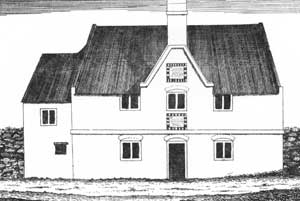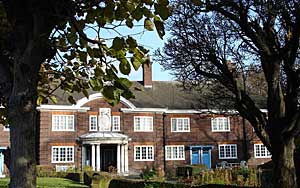

Bilby's Hospital, Nottingham (from Deering's 'Nottinghamia Vetus et Nova', 1750).
Almshouses have their origins in the medieval ecclesiastical institutions. The giving of alms was a Christian duty and both giver and recipient benefitted from this. The poor and needy were given relief at the gates of religious houses; the wealthy benefactors would give endowments to churches and monasteries and be remembered for their kindness in times to come. The alms were intended for those people who were no longer able to support themselves, usually the elderly but also the infirm. This was an age before pensions.
The biggest upheaval to this form of philanthropy came when Henry VIII broke with the Church of Rome, the period known as the Reformation in the 1530s and 1540s. The King needed money, and he dissolved the religious houses, and took their treasures so that in one stroke he filled his coffers, denied help to the poor people and made many members of religious orders homeless. Many folk were in desperate need. By the time Elizabeth I became Queen in 1558 she had no option but to address the problem. This was a time of poor harvests coupled with an increase in population so people were starving and there was a gradual drift away from villages to towns in order to find work. This led to the introduction of poor relief from the parish, but this never displaced almshouses.
Some almshouses were originally for specific groups, such as elderly trades-people of one occupation or another, and, even more likely the widows of such trades-people. Early almshouses were known as hospitals and although many of these have disappeared it is still possible to find their location through place names such as ‘spital road’. There are almshouses on Spital Road in Blyth close to where the original ones were situated. The architecture of these early hospitals was basically plain and often comprising communal hall with beds down either side of the hall and an altar at one end in order that the ‘inmates’ could take part in the religious services. The hospitals were known by several other names, such as almshouses, god’s houses, maison dieu and bedehouses.
The later almshouses tended to have a particular architectural style, usually as multiple small terraced houses or apartments, each designed for only one or two people with two rooms and a kitchen; in other words they were not intended as family accommodation. The architecture of hospitals gradually became more elaborate, with many more being built around quadrangles and also having a separate chapel. They were generally found close to a church in order that the alms person could say prayers for their benefactor. The benefactors usually had a way of showing their generosity with great visibility. In addition to the provision of accommodation there was generally a gift of clothing as well as food, fuel and money. The clothing was usually a cloak or gown of stout, serviceable material, generally blue, grey or brown. Some of the gifts were given at great religious festivals such as Christmas.
Today there is no straightforward distinction between almshouses and other types of sheltered housing, but they are usually distinguished by being maintained by a charitable trust with the aim of supporting the continued independence of the residents. They were always distinct from publicly funded institutions such as the workhouse and poor house.

The Albert Ball Memorial Homes in Lenton © Copyright Oxymoron and licensed for reuse under this Creative Commons Licence.
From the late 18th century almshouses were increasingly set up by wealthy individuals who, having made money, endeavored to set their stamp on a community. There are a number of such almshouses in and around Nottingham which fit this criteria, for example, Albert Ball Memorial Homes at Old Lenton; Dorothy Boot Homes in Wilford (now occupied as private homes); stocking manufacturer Jonathan Labray’s almshouses which were situated on Derby Road near to St Barnabas Cathedral (demolished in 1956) and the Levick Almshouses, in the Meadows set up in 1879 in memory of George Levick, a prominent Nottingham silk merchant.
In a recent publication which has researched almshouses up to 1919 there are 30 almshouses listed in Nottinghamshire and another 30 in Nottingham. There are a significant number of almshouses still functional in the county and some buildings which are no longer almshouses but remain as dwellings.
One of the distinguishing features of the dwellings was that their facades were often rather grand and impressive in order to show off to the world the importance and wealth of the benefactor.
The following houses are still in existence:
- St Leonard’s Hospital in Newark
- Plumptre Hospital, Poplar Street, Nottingham, founded in 1392
- George Willoughby’s Hospital on Church Lane, Cossall, built in 1685
- Parkyn’s Hospital, Bunny, built by Sir Thomas Parkyns in 1700
- Albert Ball Memorial homes, Lenton, built to accommodate the widows and mothers of Lenton servicemen killed in World War I were opened in 1922
- The Sir John Robinson’s Almshouses in Daybrook date from 1899 and are situated next to the old Home Ales Brewery building on Mansfield Road, Daybrook
- Collins Homes situated on Derby Road, Beeston, the successors of the Abel Collins Almshouses on Friar Lane (demolished in 1956) and Carrington Street (demolished) in Nottingham